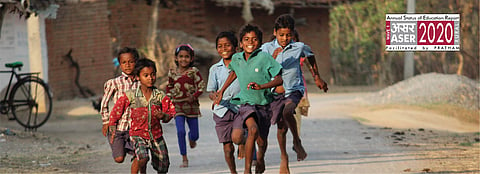

Despite the massive pervasion of smartphones and cheap internet in rural India, a whopping 43 per cent of students studying in government schools did not have access to a smartphone, found an Aser study. But among those who did have access, nearly 90 per cent said that they received notes and material through WhatsApp.
Aser Centre is an organisation that does large scale surveys using simple yet rigorous methods to generate evidence on the outcomes of social sector programs. ‘Large sums of money are channelled into social sector programs — education, health, nutrition, and livelihoods, among others. Lack of information on how these investments translate into outcomes on the ground is a major barrier to evaluating their effectiveness and determining whether taxpayers’ money is being well spent’, the Centre says on their site. This past September, the Centre surveyed rural districts in the country to find out how education has been impacted by COVID with regard to enrollments, access to learning materials and classes and the support that students had in these regions.
In the September 2020 report, Aser surveyed 584 districts out of 619 districts and questioned citizens on children’s enrollment, household resources available to children, education levels of parents, availability of smartphones, learning support for children, teacher’s experience and engagement with students and the involvement of the community in children’s education. Aser found that many schools had shut down because of the pandemic due to financial constraints. The survey noted that there had been a sharp shift from private schools to government schools due to financial strain on parents and also due to the permanent closure of several schools. The non- enrollment for ages 6-10 seems to have increased with the percentage being 1.8 percent for boys in 2018 and now 5.3 percent in 2020 with the numbers being similar to the female population well. However, the analysts find that the numbers could differ quite a bit after the schools physically open. Another reason that parents gave for the low rates of enrollment is that since schools are still shut, many young children are still awaiting admissions to the first standard.
Aser compared how the standard of education that a parent was able to get was proportional to how many could afford smartphones. About 45 percent of students with parents with ‘low (lesser than fifth standard)’ level of education managed to have smartphones at home, 79 percent children with parents with ‘high’ education had access to phones. Similarly, 84 per cent of the first category were enrolled in government schools while 53 per cent of the second group had enrolled in government schools. Overall, 43 per cent of students studying in government schools did not have a smartphone at home. Households with smartphones have increased drastically from 36 to 61 per cent in the last two years. About one in ten households bought phones after the schools shut down in March 2020. Some children though had access but only through a neighbour’s phone, the report states.
Only about one third of the children received learning materials from their teacher during the pandemic but the numbers were higher in private schools in comparison to government schools. WhatsApp happened to be the most used phone application especially among the government school children, Aser found. About 83 per cent of the children got all their learning materials through WhatsApp. But half of the students who didn’t have smartphones accessed materials only through physical visits or phone calls, parents told Aser. However, even though only one third of the students received materials, the survey showed that most of the students had engaged in related activities when they had all they needed in hand. But parents also attributed the lack of access to learning material to the schools sometimes. Even when it came to parent’s interaction with teachers, the survey showed that parents with a higher education had more engagement with the teachers. Households with educated parents were also able to help their children more, leaving those deprived of education helpless when it came to helping with their children’s school work.
Teachers told the surveyors that they had at least half their student’s phone numbers but they did not have adequate training to handle the situation of remote learning. The majority who did say they received training, mostly got only brief instructions and mostly online. Interestingly, the team also found out how many students had depended on other community members for help, these community members included — Village Heads or Ward Members, NGO or local volunteers, older children, parents or caregivers, anganwadi workers and SMC workers. Here the numbers varied between states, for example, in Kerala many received help from NGOs or volunteers while in states like Rajasthan and Punjab many teachers received help from anganwadi workers. But seven out of ten did receive support from other members of the community.
